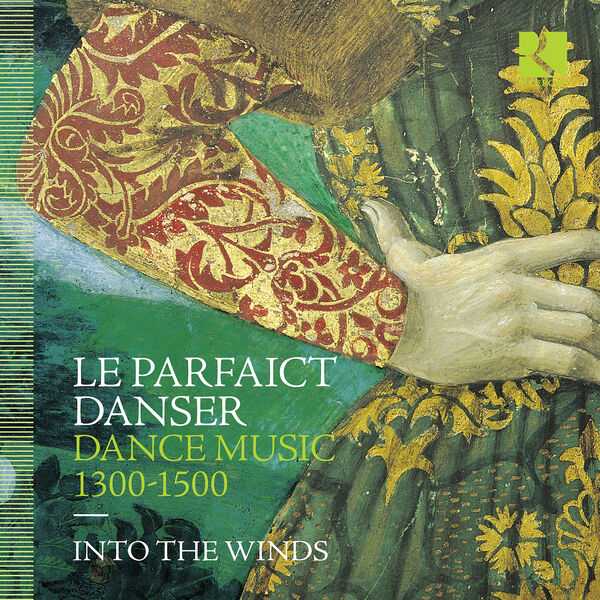

Composer: Thoinot Arbeau, Pierre Attaingnant, Gilles Binchois, Claude Gervaise, Heinrich Isaac, Diego Ortiz, Hilaire Penet, Domenico da Piacenza, Vincenzo Ruffo, Claudin de Sermisy, Francisco de la Torre
Performer: Into the Winds
Format: FLAC (tracks)
Label: Ricercar
Catalogue: RIC452
Release: 2023
Size: 1.86 GB
Recovery: +3%
Scan: yes
01ю anon.: La Tierche Estampie Roial & Danse
02ю anon.: Suite de ducties
03. anon.: Retrove
04. anon.: La Manfredina & La Rotta
05. Piacenza: Bassadanze Zoglioxa (Arr. for Wind Ensemble and Percussion by Pascale Boquet)
06. Cornazzano: La Figlia di Guglielmino
07. Ambrosio, Pesaro: Ballo Francese chiamato Amoroso (Arr. for Wind Ensemble and Percussion by Pascale Boquet)
08. Ambrosio: Ballo Francese chiamato Petit Rinense (Arr. for Wind Ensemble and Percussion by Nicolas Sansarlat)
09. Ambrosio: Voltate in Ça Rosina (Arr. for Wind Ensemble and Percussion by Ian Harrison)
10. Cornazzano: Re di Spagna (Arr. for Wind Ensemble and Percussion by Pascale Boquet)
11. Torre: Danza alta
Isaac: Missa “La Spagna”
12. II. Gloria
13. V. Agnus Dei
14. Binchois: Triste plaisirs
15. anon.: Basse-danse Triste plaisirs (Arr. for Wind Ensemble and Percussion by Pascale Boquet)
16. anon.: Pavane La Monina (Arr. for Wind Ensemble and Percussion by Adrien Reboisson)
17. anon.: Saltarello – La Comarina
18. anon.: Ballo Tentalora
19. anon.: Saltarello El Marchese di Saluzzo
20. Penet: Au joly boys
21. Sermisy: Au joly boys
22. Ruffo: La Gamba in Basso, e Soprano
23. Ortiz: Recercada Quarta (Arr. for Wind Ensemble and Percussion by Adrien Reboisson)
24. Arbeau: Basse-danse Jouissance vous donneray (Arr. for Wind Ensemble and Percussion by Pascale Boquet)
25. Attaingnant: Second livre de danseries: Tourdion C’est grand plaisir
26. Gervaise, Phalese: Sixième livre de danseries: Pavane Passemaize, Passemèzes d’Italie & Gaillarde
27. Gervaise: Troisième livre de danseries: Suite d’Allemandes
28. d’Estrées: Premier livre de danseries: Suite de Bransles de Champaigne
29. Attaingnant: Neuf basse dances: Basse-danse La Brosse
30. anon.: Gallicum Sine Nomine
31. d’Estrées: Premier livre de danseries: Suite de branles gay
The perfect dancing is memory, tempo, style, how the body is held, the diversity of things and the sharing of space…”. So begins one of the first dance treatises in history, written by the Italian dancing master Antonio Cornazzano in the 15th century. To go beyond the steps and figures he describes is to understand the symbolic role of this art, its aim to unite earthbound humanity with the kingdom of God. This recording echoes this universalist vision, following the thread of the first notated dances and exploring the songs or pieces that were sometimes also the source and inspiration of more refined compositions: Estampies and other forgotten dances of the Middle Ages; aristocratic bassedanses that were in vogue at the court of Burgundy; saltarelli of the bourgeoning Italian Renaissance; allemandes and heady branles danced at the revels of François I. On this recording, Into the Winds gleefully explores a great variety of spaces and aesthetics and reveal the timelessness of this art more than ever.
It may seem surprising to find an album devoted to dance music from 1300 to 1500 on classical best-seller lists in the spring of 2023. This is a niche slice of the market at best, but after one hears the music of the new ensemble Into the Winds, it will be understandable. Part of the innovation here is just the breadth of repertory represented. Instrumental dances are generally interspersed among vocal pieces, and few performers in performances or on recordings have addressed them as a genre of their own. Into the Winds offers music ranging from simple medieval pieces to transcriptions of vocal polyphony, including a mass by Heinrich Isaac. Beyond this is the crack playing and the intelligent sequencing. All of the players except for percussionist Laurent Sauron trade off among instruments, and there are unusual sonorities at every turn here from such instruments as medieval bassoons with well-thought-out arrangements of several pieces. Many of the composers are anonymous, but others have names and are known, and a recording like this begins to make possible an evaluation of their music. This is a pioneering recording and one that is entertaining for anybody.